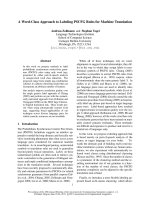Design a surface flow CWs to treat domestic wastewater for an residential area
Bạn đang xem bản rút gọn của tài liệu. Xem và tải ngay bản đầy đủ của tài liệu tại đây (588.82 KB, 24 trang )
Group 11
Đặng Minh Sơn
Nguyễn Quang Văn
Nguyễn Thanh Tùng
Vũ Thị Thu Trang
Content
I. Introduction
II. Designing
1.Domestic wastewater compositions
2.CWs calculation
3.Vegetation and Soil
III. Result
IV. Conclusion
I. Introduction
Our topic:
• Design a surface flow CWs to treat domestic
wastewater of a residential area of 1000 people
(Assume that 1 person consume 150 lit water/day and
wastewater amount is 80% of water supply)
We choose to use horizontal surface flow CW for this
design.
Wastewater treatment by wetland
• First made by
Seidel (1955) at the
Max Planck Institute in Plon,
Germany
• Applied and developed countries
in Europe, America, Australia ...
in the years from 1970 to 2000
• Vietnam : that method was done
at universities, research institutes
in recent years and got some
initial encouraging result
Most domestic wastewater in the residential urban,
suburban and rural Vietnam are not handled properly.
Wastewater from toilets only preliminary treatment,
unsatisfactory discharge into the evironment has been
mixed with waste water from the kitchen, bathroom,
laundry ... cause pollution, the spread of diseases
Free water surface (FWS)
• These systems typically consist of basins or
channels, with some sort of subsurface barrier
toprevent seepage, soil or another suitable
medium to support the emergent vegetation, and
water at a relatively shallow depth flowing
through the unit. The shallow water depth, low
flow velocity, and presence of the plant stalks
and litter regulate water flow and, especially in
long, narrow channels minimize short circuiting.
II. Designing
1. Domestic wastewater compositions
2. CWs calculation
3. Vegetation and Soil
1. Domestic wastewater compositions
Domestic wastewater contains BOD, SS, NH4+, Nitrogen,
Phosphorus, Microorganisms….
Table1: Typically polluted concentration and compositions
Compositions
Unit
Amount
1
pH
-
6.5 - 8.5
2
BOD5
mg/l
250 – 400
3
COD
mg/l
400 – 700
4
TSS
mg/l
300 – 400
5
Total Nitrogen
mg/l
60
6
Total Phosphorus
mg/l
6.86
• Wastewater treating is in order to remove
contaminants before discharging to the culverts
or recycling
• Water quality after treatment must satisfy the
National technical regulation on domestic
wastewater – QCVN 14:2008/BTNMT
Compositions
Unit
Amount
(influence) Co
Amount
(effluence) Ce
1
pH
-
6.5 - 8.5
5–9
-
2
BOD5
mg/l
250 – 400
30
8 – 13 times
higher
3
COD
mg/l
400 – 700
-
-
4
TSS
mg/l
300 – 400
50
6 – 8 times
higher
5
Total Nitrogen
mg/l
60
30
-
6
Total
Phosphorus
mg/l
6.86
6
-
TSS can be easily removed focus on BOD5
Table2: Value of maximum parameter allowed used for calculating in domestic
wastewater
Parameter
Unit
Concentration C
A
B
1
pH
-
5–9
5-9
2
BOD5 (20oC)
mg/l
30
50
3
Total suspended solid (TSS) mg/l
50
100
4
Total dissolved solid (TDS)
mg/l
500
1000
5
Sulfur (H2S)
mg/l
1.0
4.0
6
Ammonium
mg/l
5
10
7
Nitrate (NO3-)
mg/l
30
50
8
Lipid
mg/l
10
20
9
Surface active agents
mg/l
5
10
10
Phosphate (PO43-)
mg/l
6
10
11
Total Coliforms
MPN/100 ml
3000
5000
A: for domestic supply purpose
B: not for domestic supply purpose
2. CWs calculation
• Problem requirement: Design a surface flow
CWs to treat domestic wastewater of a
residential area of 1000 people (Assume
that 1 person consume 150 lit water/day
and wastewater amount is 80% of water
supply)
BOD5 Removal in FWS Wetlands
Ce
= Ae
Co
−0.7 KT ( Av )1.75 As dn
Q
where,
A = fraction of BOD5 not removed as settleable solids near headworks of the system
(as decimal fraction)
Av = specific surface area for microbial activity, m 2/m3
As = wetland treatment area, m2
d = design depth of system, m
n = porosity of system (as a decimal fraction)
Q = average hydraulic loading on the system, m3/day
K T = temperature-dependent rate constant KT (in day-1) at water temperature T ( oC)
Ce
= Ae
Co
−0.7 KT ( Av )1.75 As dn
Q
A sample calculation for the
above coefficients equation
yields the following results:
• A = 0.52
• K20 = 0.0057 day-1
• Av = 15.7 m2/m3
• d = 0.6m (recommended)
• n = Vv/V = 0.75
(Vv & V: volume of voids and
total volume)
As= ? (m2)
Q = average hydraulic loading
on the system, m3/day:
Q = 1,000people x
150L/person/day x 80%
=120,000L/day =120m3 /day
KT = K20 x (1.1)T-20
= 0.0057 day-1 x (1.1)25-20
= 9.2 x 10-3
Average ToC of water is 25oC
K20 is rate constant at 20oC
50
= 0.52e
Co
−0.7×9.2×10 −3 ×15.71.75 × As ×0.6×0.75
120
As ranges from 320.67 m2 to 478.36m2
Assume, length : width = 3 : 1
The length is about 32m ~ 38m
The width is about 10m ~ 13m
3. Soil and Plant
• Soil Permeability for Free Water
Surface Systems
• The most desirable soil
permeability is 10-6 to 10-7m/s
(0.14-0.014 in/hr). Sandy clays
and silty clay loams can be
suitable when compacted.
• Canna Hybrid: Strong growth
at contaminated wetlands
good for NH4+, NO3-, PO43removal
III. Result
For 1000 people:
-Organic loading:
< 112kg BOD5
-Hydraulic loading: 0.7-5.0 cm/day
-Detention time:
5-15 days
20-30 cm
Conclusion
• In terms of social topics will contribute to improving
the health of communities through clean water and
create a good view from the technology underground
leach plant.
• In terms of biodiversity conservation: Thread has
created a good view and contribute to increase
biodiversity in areas with abundant types of crops in
the leach..
• In terms of economic and biodiversity: This type of
model wastewater by biological treatment principle
does not need to use energy saving will be very
effective and economical when applied in practice
than other methods. In addition, the leach plant can
be used as feed for livestock. Treated water can
circulate to bathe using pigs, barn wash or irrigate
crops are good.
THANK YOU FOR LISTENING









